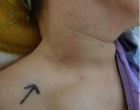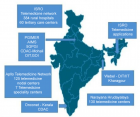Abstract
Short Communication
Cyn d 1 airborne allergen in a Southern Brazilian city
Cinthya Covessi Thom de Souza*, Nelson Augusto Rosario Filho, Ernesto Akio Taketomi, Juliana Silva Miranda and Ricardo Henrique Moreton Godoi
Published: 26 February, 2021 | Volume 5 - Issue 1 | Pages: 014-016
By researching the factors related to exposure to indoor and outdoor allergens, such seasons, climate changes and particulate matter, allergists can screen the sensitization profile of individuals according to their exposures and conduct preventive treatment and individualized immunotherapy. Molecular allergology has improved aerobiological screening of allergenic components toward more specific results on allergic exposure, sensitization, and symptoms [1,2]. The Enzyme-Linked Immunosorbent Assay (ELISA) is a colorimetric enzyme immunoassay technique used to quantify soluble substances such as proteins, peptides, antibodies, and hormones. Due to its high sensitivity and specificity, ELISA can quantify substances at low concentrations, such as allergens [3].
Read Full Article HTML DOI: 10.29328/journal.aaai.1001024 Cite this Article Read Full Article PDF
Keywords:
Pollinosis; Grass pollen; Cynodon; Air samples; ELISA
References
- Buters JTM. Pollen allergens and geographical factors. In: Akdis C, Agache I, editors. Global atlas of allergy- EAACI. Zurich, 2014, Chapter 31: 36–38.
- Baldelli A, Jeronimo M, Loosley B, Owen G, Welch I, et al. Particle matter, volatile organic compounds, and occupational allergens: correlation and sources in laboratory animal facilities. SN Applied Sci. 2020; 2: 1-14.
- Zahradnik E, Sander I, Bruckmaier L, Flagge A, Fleischer C, et al. Development of a sandwich ELISA to measure exposure to occupational cow hair allergens. Int Arch Allergy Immunol. 2011; 155: 225-233. PubMed: https://pubmed.ncbi.nlm.nih.gov/21282961/
- Vieira FA, Ferreira EN, Cruz AA. Grass allergy may increase the risk of tree pollinosis. A warning to urban planners. J Allergy Clin Immunol. 1998; 102: 700-701. PubMed: https://pubmed.ncbi.nlm.nih.gov/9802385/
- Rosário NA. Pollinosis in Brazil: changing concepts. J Allergy Clin Immunol. 1990; 85: 819-820. PubMed: https://pubmed.ncbi.nlm.nih.gov/2324422/
- Rosário Filho NA. Contagem de polens aéreos na cidade de Curitiba. Rev Bras Alerg Imunopatol. 1983; 6: 12-15.
- Vieira FAM. Gramíneas tropicais alergênicas: Cynodon dactylon e Paspalum notatum - uma visão para o trópico brasileiro. Rev Bras Alerg Imunopatol. 2012: 35: 40-41.
- D'Amato G, Chong-Neto HJ, Monge Ortega OP, Vitale C, Ansotegui I, et al. The effects of climate change on respiratory allergy and asthma induced by pollen and mold allergens. Allergy. 2020; 75: 2219-2228. PubMed: https://pubmed.ncbi.nlm.nih.gov/32589303/
- Camargo J, Brill S, Thom de Souza C, Sebben B, Pauliquevis T, et al. The advance in Poaceae pollen seasonality pattern may impact allergy treatment practice. J Allergy Clin Immunol. 2021; 147: AB85.
- Bernardes CT, Moreira PF, Sopelete MC, Viera FA, Sung SS, et al. IgE cross-reactivity between Lolium multiflorum and commercial grass pollen allergen extracts in Brazilian patients with polinosis. Braz J Med Biol Res. 2010; 43: 166-175. PubMed: https://pubmed.ncbi.nlm.nih.gov/20098843/
- García-Mozo H. Poaceae pollen as the leading aeroallergen worldwide: A review. Allergy. 2017; 72: 1849-1858. PubMed: https://pubmed.ncbi.nlm.nih.gov/28543717/
- Araujo, LML, Rosário NA, Mari A. Molecular-based diagnosis of respiratory allergic diseases in children from Curitiba, a city in Southern Brazil. Allergol Immunopathol (Madr). 2016; 44: 18-22. PubMed: https://pubmed.ncbi.nlm.nih.gov/25982581/
- Duffort O, Calabozo B, González R, Carpizo JA, Barber D, Polo F. Monoclonal antibody-based ELISA to quantify the major allergen of Cynodon dactylon (Bermuda grass) pollen, Cyn d 1. Int Arch Allergy Immunol. 2004; 135: 277-283. PubMed: https://pubmed.ncbi.nlm.nih.gov/15564768/
- Rousseau DD, Schevin P, Duzer D, Cambon G, Ferrier J, et al. New evidence of long distance pollen transport to southern Greenland in late spring. Rev Palaeobotany Palynol. 2006; 141: 277–286.
- Moreira PFS, Gangl K, Vieira FAM, Ynque LH, Linhart B, et al. Allergen Microarray Indicates Pooideae sensitization in Brazilian grass pollen allergic patients. PLoS ONE. 2015; 10: e0128402. PubMed: https://pubmed.ncbi.nlm.nih.gov/26067084/
- Vergamini SMN, Zoppas BCDA, Valencia-Barrera RM, Fernandez-Gonzalez D. Dinâmica aeropalinológica de Gramineae na cidade de Caxias do Sul, RS. Rev. Bras. Alerg Imunopatol. 2006; 29: 14-17.
- Davies JM, Matricardi PM, Schmid J. Grass Pollen Allergy. In: In EAACI Molecular Allergology user’s Guide – EAACI, Zurich, 2016: 85-94.
- Kailaivasan TH, Timbrell VL, Solley G, Smith WB, McLean-Tooke A, et al. Biogeographical variation in specific IgE recognition of temperate and subtropical grass pollen allergens in allergic rhinitis patients. Clin Translational Immunol. 2020; 9: e1103. PubMed: https://www.ncbi.nlm.nih.gov/pmc/articles/PMC6997006/
- Cabauatan CR, Lupinek C, Scheiblhofer S, Weiss R, Focke-Tejkl M, et al. Allergen microarray detects high prevalence of asymptomatic IgE sensitizations to tropical pollen-derived carbohydrates. J Allergy Clin Immunol. 2014; 133: 910-914. PubMed: https://www.ncbi.nlm.nih.gov/pmc/articles/PMC6597356/
Similar Articles
-
Cyn d 1 airborne allergen in a Southern Brazilian cityCinthya Covessi Thom de Souza*,Nelson Augusto Rosario Filho,Ernesto Akio Taketomi,Juliana Silva Miranda,Ricardo Henrique Moreton Godoi. Cyn d 1 airborne allergen in a Southern Brazilian city. . 2021 doi: 10.29328/journal.aaai.1001024; 5: 014-016
Recently Viewed
-
Sex after Neurosurgery–Limitations, Recommendations, and the Impact on Patient’s Well-beingMor Levi Rivka*, Csaba L Dégi. Sex after Neurosurgery–Limitations, Recommendations, and the Impact on Patient’s Well-being. J Neurosci Neurol Disord. 2024: doi: 10.29328/journal.jnnd.1001099; 8: 064-068
-
Physiotherapy Undergraduate Students’ Perception About Clinical Education; A Qualitative StudyPravakar Timalsina*,Bimika Khadgi. Physiotherapy Undergraduate Students’ Perception About Clinical Education; A Qualitative Study. J Nov Physiother Rehabil. 2024: doi: 10.29328/journal.jnpr.1001063; 8: 043-052
-
Clinical Significance of Anterograde Angiography for Preoperative Evaluation in Patients with Varicose VeinsYi Liu,Dong Liu#,Junchen Li#,Tianqing Yao,Yincheng Ran,Ke Tian,Haonan Zhou,Lei Zhou,Zhumin Cao*,Kai Deng*. Clinical Significance of Anterograde Angiography for Preoperative Evaluation in Patients with Varicose Veins. J Radiol Oncol. 2025: doi: 10.29328/journal.jro.1001073; 9: 001-006
-
Regional Anesthesia Challenges in a Pregnant Patient with VACTERL Association: A Case ReportUzma Khanam*,Abid,Bhagyashri V Kumbar. Regional Anesthesia Challenges in a Pregnant Patient with VACTERL Association: A Case Report. Int J Clin Anesth Res. 2025: doi: 10.29328/journal.ijcar.1001027; 9: 010-012
-
Cystoid Macular Oedema Secondary to Bimatoprost in a Patient with Primary Open Angle GlaucomaKonstantinos Kyratzoglou*,Katie Morton. Cystoid Macular Oedema Secondary to Bimatoprost in a Patient with Primary Open Angle Glaucoma. Int J Clin Exp Ophthalmol. 2025: doi: 10.29328/journal.ijceo.1001059; 9: 001-003
Most Viewed
-
Evaluation of Biostimulants Based on Recovered Protein Hydrolysates from Animal By-products as Plant Growth EnhancersH Pérez-Aguilar*, M Lacruz-Asaro, F Arán-Ais. Evaluation of Biostimulants Based on Recovered Protein Hydrolysates from Animal By-products as Plant Growth Enhancers. J Plant Sci Phytopathol. 2023 doi: 10.29328/journal.jpsp.1001104; 7: 042-047
-
Sinonasal Myxoma Extending into the Orbit in a 4-Year Old: A Case PresentationJulian A Purrinos*, Ramzi Younis. Sinonasal Myxoma Extending into the Orbit in a 4-Year Old: A Case Presentation. Arch Case Rep. 2024 doi: 10.29328/journal.acr.1001099; 8: 075-077
-
Feasibility study of magnetic sensing for detecting single-neuron action potentialsDenis Tonini,Kai Wu,Renata Saha,Jian-Ping Wang*. Feasibility study of magnetic sensing for detecting single-neuron action potentials. Ann Biomed Sci Eng. 2022 doi: 10.29328/journal.abse.1001018; 6: 019-029
-
Pediatric Dysgerminoma: Unveiling a Rare Ovarian TumorFaten Limaiem*, Khalil Saffar, Ahmed Halouani. Pediatric Dysgerminoma: Unveiling a Rare Ovarian Tumor. Arch Case Rep. 2024 doi: 10.29328/journal.acr.1001087; 8: 010-013
-
Physical activity can change the physiological and psychological circumstances during COVID-19 pandemic: A narrative reviewKhashayar Maroufi*. Physical activity can change the physiological and psychological circumstances during COVID-19 pandemic: A narrative review. J Sports Med Ther. 2021 doi: 10.29328/journal.jsmt.1001051; 6: 001-007

HSPI: We're glad you're here. Please click "create a new Query" if you are a new visitor to our website and need further information from us.
If you are already a member of our network and need to keep track of any developments regarding a question you have already submitted, click "take me to my Query."

















































































































































